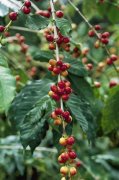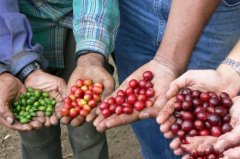Legend of Coffee basic knowledge of Fine Coffee beans

Coffee flower
Carved white jade leaves, coral beads knot.
Looking at the coffee in the rain, I couldn't bear to go back.
The flowers often bring rain, and the smell is as strong as milk.
The mountain birds call at night and pick up fallen pearls in the Ming Dynasty.
When I walked into the coffee garden in May and June, I saw the oval pea-sized coffee fruit that you wouldn't let me. I wanted to press you, you were next to me, and I squeezed you, gathering in the petiole one by one, bending the branches: green and green, like green jade balls, ripe bright red and exquisite, like red coral beads.
At present, coffee, as an elegant, fashionable and high-grade beverage, has long been popular all over the world, and has been listed as the first of the three major beverages (coffee, tea and cocoa) in the world. Coffee is also grown in 76 countries and regions all over the world. In 1983-1984 alone, the world's coffee output reached 5.5 million tons, with exports of 4.2 million tons. Among them, Brazil in South America, known as the "coffee kingdom", has the largest production and export volume. In spite of this, the hometown of coffee is not in Brazil, but in Ethiopia in Africa. to this day, there is still a large area of wild coffee forest in the dense jungle of the southwestern province of Cafa. The word "coffee" comes from the place name "Kafa".
There are many legends about the discovery of coffee. There is a legend that in the 13th century, there was a prince in Ethiopia who found that his camel loved to eat a small oar fruit on a bush, and he was very excited and energetic after eating it. So he also picked some small berries to taste, and finally discovered this refreshing coffee drink. Another legend is that one day in 500 BC, an Ethiopian shepherd herded his sheep to a strange place for grazing. On a small hill, the sheep ate a kind of small red fruit on a small tree. after returning in the evening, the sheep were unusual in the fence, not as peaceful and docile as usual, but excited, restless, tearing and shouting, and even jumping all night long. The owner thought that the sheep had been poisoned by eating some grass and got up several times to take a closer look at the lights, but they saw the sheep in high spirits and alive. It doesn't look like poisoning pain. The next morning, the shepherd was ready to drive the sheep to another place for grazing. After opening the fence, the sheep ran desperately to the mountain with little red fruit. No matter how the shepherd whipped to stop it, when the shepherd was exhausted, he had to follow the sheep to the hill. The shepherd was very surprised to see each sheep scrambling to eat the little red fruit, so he picked some small red fruit and chewed it over and over again and found that the little red fruit was sweet with some bitterness. When he returned from grazing, the shepherd felt so excited that he couldn't sleep all night. He even wanted to dance with the hands of the sheep and dance with his feet. The magic of the little red fruit spread quickly, and the shepherds of Ethiopia picked and chewed the little red fruit everywhere and sold it on the market. Later, this little red fruit developed into the most popular coffee drink in the world today.
In fact, the Arabs began to grow coffee in 525 BC, and chewing fried coffee beans became popular in the Arab region. In 890 AD, Arab merchants sold coffee beans to Yemen, and Yemenis made coffee beans into drinks for the first time. In the 15th century, coffee was introduced into Europe, Asia and soon into America. By the 18th century, coffee was widely grown in tropical and subtropical regions of the world and became one of the three major drinks in the world. Coffee ranks first among the top three beverages in annual sales, three times as much as cocoa and four times as much as tea. Although coffee has been cultivated in the world for more than 2000 years. However, coffee has been cultivated in China for only a few hundred years. In 1884, Taiwan Province began to introduce coffee. At the beginning of the 20th century, overseas Chinese brought coffee back from Malaysia to grow in Hainan Province. Later, tropical and subtropical provinces in the south began to grow plant coffee one after another. Although the cultivation time is short, the coffee from Hainan and Yunnan provinces in China has excellent quality and unique charm, so it enjoys a high reputation in the world. After some foreign businessmen buy it at a low price, it is processed and sold to the international market. It has become an expensive world-class drink, especially the small-grain coffee grown in Yunnan Province. Because of the large temperature difference between day and night in Yunnan, it is conducive to the accumulation of substances in it. So it tastes strong but not bitter, fragrant but not strong, oily and fruity, so it is praised as "the best quality coffee in the world" by coffee merchants at home and abroad.
Coffee is a small perennial evergreen tree of Rubiaceae, which is a horticultural perennial cash crop with the characteristics of fast growth, high yield, high value and wide market. Coffee varieties can be divided into small-grain, medium-grain and large-grain species, the former contains low caffeine content and strong flavor, while the latter two have high caffeine content but poor flavor. At present, coffee sold in the world is generally made of small and medium seeds in different proportions, usually 70% of medium seeds, mainly caffeine, and 30% of small seeds, mainly for their aroma. Each coffee variety generally has a few to a dozen variants. Coffee is more resistant to shade and cold, but not resistant to light, drought and disease. Coffee contains nine kinds of nutrients, such as caffeine, protein, crude fat, crude fiber and sucrose. As a beverage, coffee is not only mellow and delicious, slightly bitter and sweet, but also can excite nerves and dispel fatigue. In medicine, caffeine can be used as an anesthetic, stimulant, diuretic and cardiotonic, as well as to help digestion and promote metabolism. The pulp of coffee is rich in sugar and can be used to make sugar and alcohol. Coffee flowers contain essential oils that can be used to extract high-grade spices.
Important Notice :
前街咖啡 FrontStreet Coffee has moved to new addredd:
FrontStreet Coffee Address: 315,Donghua East Road,GuangZhou
Tel:020 38364473
- Prev

Basic knowledge of high-quality coffee the planting conditions of coffee trees
Coffee tree coffee (Xoffea arabica Linn) coffee is a perennial evergreen shrub or small tree of Rubiaceae. It is a horticultural perennial cash crop with the characteristics of fast growth, high yield, high value and wide market. Wild coffee trees can grow to 5 to 10 meters high, but coffee trees planted on manors are often cut to less than 2 meters in order to increase fruit and facilitate harvesting.
- Next

How much do you know about coffee?
Coffee (Xoffea arabica Linn) is a perennial evergreen shrub or small tree of Rubiaceae. It is a kind of horticultural perennial economic crop with the characteristics of fast growth, high yield, high value and wide market. Wild coffee trees can grow to 5 to 10 meters tall, but coffee trees grown on plantations are cut to less than 2 meters in order to increase fruit yield and facilitate harvesting. coffee
Related
- Beginners will see the "Coffee pull flower" guide!
- What is the difference between ice blog purified milk and ordinary milk coffee?
- Why is the Philippines the largest producer of crops in Liberia?
- For coffee extraction, should the fine powder be retained?
- How does extracted espresso fill pressed powder? How much strength does it take to press the powder?
- How to make jasmine cold extract coffee? Is the jasmine + latte good?
- Will this little toy really make the coffee taste better? How does Lily Drip affect coffee extraction?
- Will the action of slapping the filter cup also affect coffee extraction?
- What's the difference between powder-to-water ratio and powder-to-liquid ratio?
- What is the Ethiopian local species? What does it have to do with Heirloom native species?

